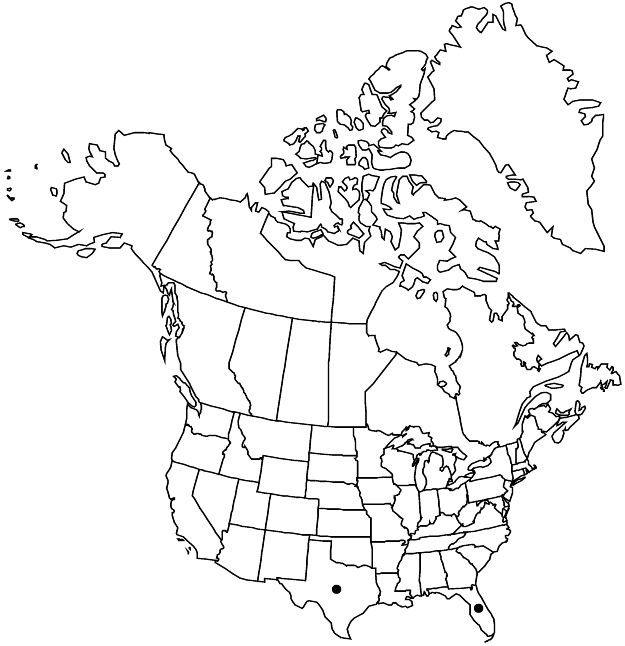Passiflora pallida
Sp. Pl. 2: 955. 1753.
Stems terete, glabrous or sparsely hairy, (bark with corky ridges or wings). Leaves not pungent, glabrous or sparsely hairy; stipules linear-subulate, 2–5 × 0.5 mm, eglandular; petiole glandular, glands clavate; blade usually symmetric, (1–) 3–10 (–17) × (0.5–) 2–6 (–14) cm, as long as to usually longer than wide, unlobed or deeply 3-lobed, middle lobe longer than lateral lobes, or asymmetrically 2-lobed or 3-lobed with 1 lateral lobe greatly reduced or absent, lobes rounded to acute, margins entire; abaxial fine veins moderately to prominently raised, abaxial nectaries absent. Floral bracts absent or minute. Flowers: floral-tube absent; sepals green, often becoming purple, 4–8 × 2–3 mm; petals absent; corona filament whorls 2, outer filaments green, green-white, or purple basally, yellow apically, linear, terete, 2–4 mm. Berries blue-black, globose to ovoid, 5–13 × 5–10 mm. 2n = 24.
Phenology: Flowering year-round, primarily Oct–Dec.
Habitat: Subtropical to tropical woodlands, shrublands, pine forests, scrub and disturbed areas, in rocky, loamy to sandy soil, often calcareous
Elevation: 0–60 m
Distribution

Fla., Tex., Mexico, West Indies (Bahamas), West Indies (Greater and Lesser Antilles), Bermuda, South America (Venezuela), in s Asia, Indian Ocean Islands, w Pacific Islands, n Australia
Discussion
The leaves of Passiflora pallida show variation in lobe number, from juvenile to adult plants, and within and among individuals, with both unlobed and three-lobed leaf forms most common. In Texas, leaves on mature plants are always symmetrically three-lobed; in Florida, leaves can be unlobed, symmetrically three-lobed, or asymmetrically two- to three-lobed. Passiflora pallida is also self-compatible, an unusual feature in the genus.
In peninsular Florida, Passiflora pallida is widespread and locally common to occasionally weedy. In Texas, it is relatively uncommon, known only from the extreme southernmost part of the state and from a single disjunct population about 150 miles northward in Refugio County (S. R. Hill 1981).
Traditionally synonymized under Passiflora suberosa in our region (for example, D. S. Correll and M. C. Johnston 1970; R. L. Hammer 2002; R. P. Wunderlin and B. F. Hansen 2003), P. pallida is closely related to the larger-flowered P. suberosa and commonly is treated as conspecific with it worldwide. The hypanthium of P. pallida generally is 3–4 mm in diameter, with inner coronal filaments usually less than 1.5 mm and outer filaments less than 4 mm, whereas in P. suberosa the hypanthium generally is 4–8.8 mm in diameter, with inner coronal filaments usually 1.5–3.9 mm and outer filaments (2.5–)3–8.1 mm. Passiflora suberosa is native in
Mexico, the West Indies, and Central and South America, and has been widely introduced in tropical regions (weedy in Hawaii), but does not occur in the flora area. In regions where the two species naturally co-occur, P. pallida generally is found at lower elevations than P. suberosa. These two species and close relatives were reviewed by K. E. Porter-Utley (2003).
Selected References
None.
Lower Taxa
"fine" is not a number.